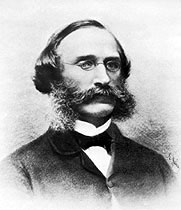William Samuel Henson
William Samuel Henson (born May 3, 1812 in Nottingham , England, † 1888 in Newark , New Jersey ), also known as Mad-man Henson , was a British inventor. Like his co-inventor Stringfellow, he earned his living in Chard as a manufacturer of spools for the local wool industry. In 1848 he emigrated to the United States of America . There he worked as an inventor, u. a. unsuccessful for the US Navy.
Inventions
In 1840, together with John Stringfellow , Henson designed , probably based on the work of Sir George Cayley , the first flying machine, which looked similar to an airplane today , and was called the Henson Aerial Steam Carriage . The span should be 45.7 m (150 feet). A steam engine of 30 hp was provided as the drive , which was supposed to set two propellers 6 m in diameter on the back of the wing in rotation against each other. Although Henson only built models, the device already had many of the features of today's aircraft. In 1843, Henson received a patent on his invention. Henson, Stringfellow, Frederick Marriott and DE Colombine founded the Aerial Transit Company to exploit the invention, but it was dissolved in 1848 after a second, larger model could not be made to fly in 1847 on the hill Bala Down near Chard. Henson left his patents to Stringfellow, who succeeded in 1848 with a motorized model airplane.
Henson u. a. for a light steam engine (1841) and a T-shaped safety razor (1847), the improvement of which by King Camp Gillette in 1901 led to the modern razor.
The Henson Glacier in Antarctica bears his name.
Magazine articles
- Henson's air steamship . In: Illustrirte Zeitung . No. 2 . J. J. Weber, Leipzig July 8, 1843, p. 23-24 ( Wikisource ).
Web links
| personal data | |
|---|---|
| SURNAME | Henson, William Samuel |
| BRIEF DESCRIPTION | English designer and pioneer of powered flight |
| DATE OF BIRTH | May 3, 1812 |
| PLACE OF BIRTH | unsure: Chard , Somerset, England |
| DATE OF DEATH | 1888 |
| Place of death | Newark (New Jersey) |

